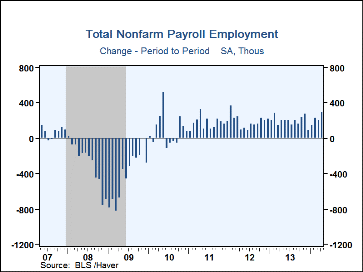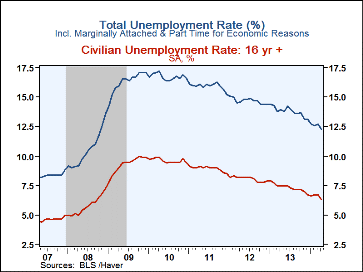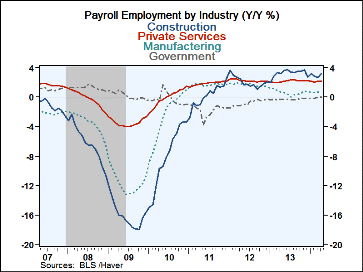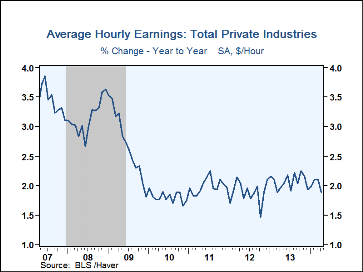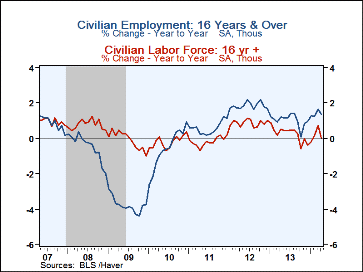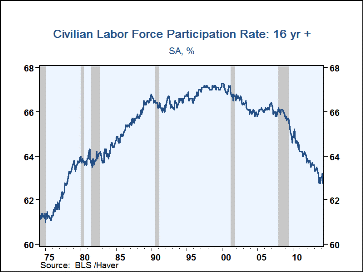 Global| May 02 2014
Global| May 02 2014U.S. Payroll Employment Gain Picks Up Steam; Jobless Rate is Lowest Since 2008
by:Tom Moeller
|in:Economy in Brief
Summary
Employers became more optimistic in April and boosted workforces by 288,000 following a 203,000 March rise, initially reported as 192,000. The rise was the strongest since January 2012 and easily outpaced expectations for a 210,000 [...]
Employers became more optimistic in April and boosted workforces by 288,000 following a 203,000 March rise, initially reported as 192,000. The rise was the strongest since January 2012 and easily outpaced expectations for a 210,000 increase in the Action Economics Forecast Survey. The unemployment rate fell sharply to 6.3% versus expectations for a dip to 6.6%. The total jobless rate, including workers who were marginally attached plus part-time for economic reasons, declined to 12.3% as individuals left the labor force in droves. Average hourly earnings were unchanged (1.9% y/y).
From the establishment survey, the 288,000 increase in employment was broad-based. Construction jobs advanced a firm 32,000 (3.3% y/y) though factory sector jobs grew a moderate 12,000 (0.8% y/y). Employment in the private service sector picked up 220,000 (2.1% y/y), the strongest rise since May of last year. It was led by a 75,000 gain (3.6% y/y) in professional & business services which was helped by a 24,000 gain (9.3% y/y) in temporary positions. Education & health services employment grew 40,000 (1.6% y/y) while leisure & hospitality jobs advanced 28,000 (2.9% y/y). Retail trade jobs grew 34,500 (2.2% y/y) but employment in the financial services industry grew just 6,000 (0.7% y/y). Government sector employment rose 15,000 (-0.0% y/y) reflecting a 17,000 rise (0.5% y/y) in local jobs, a 1,000 uptick (0.2% y/y) in state employment. Federal sector positions declined by 3,000 (-3.0% y/y).
Over a one-month span, 67.0% of private industries added to employment, near the recovery high. Moreover, 72.9% added to payrolls over a six-month span. A moderate 58.6% of manufacturing industries raised employment levels.
The length of the average workweek held steady at 34.5 hours, though that was the longest workweek of the economic expansion. The private services workweek held at 33.3 hours while the goods producing sector's workweek dipped to 40.5 hours.
Average hourly earnings also were unchanged at $24.31 (1.9% y/y). Wages in the goods producing industries slipped 0.1% to $25.59 per hour (+2.4% y/y) while private service sector earnings were unchanged at $24.01 per hour (1.7% y/y).
From the household survey, the unemployment rate's decline to 6.3% was to the lowest level since September 2008. It reflected a 73,000 worker decline (+1.4% y/y) in employment and an 806,000 drop in the labor force which was unchanged y/y. Though the population rose to 247,439, the labor force decline pulled the participation rate down to 62.8%, its lowest level since March 1978. Those who have chosen to stay out of the labor force rose 2.5% y/y. The employment-to-population ratio was modestly higher last month at 58.9%, though it had been as high as 63.1% in 2006.
The unemployment rate for those with less than a high school diploma fell sharply to 8.9%, but here the labor force fell by 308,000 (-0.6% y/y). For high school graduates with no college, the rate was stable at 6.3% but the labor force fell 303,000 (-0.4% y/y). For individuals with some college but less than a bachelors degree, the jobless rate dropped to 5.7% and the labor force grew 206,000 (0.1% y/y). For college graduates, the unemployment rate was 3.3% as the labor force grew 26,000 (1.0% y/y).
The figures referenced above are available in Haver's USECON database. Additional detail can be found in the LABOR and in the EMPL databases. The expectation figures are from Action Economics and are in the AS1REPNA database.
| Employment: (M/M Chg., 000s) | Apr | Mar | Feb | Y/Y | 2013 | 2012 | 2011 |
|---|---|---|---|---|---|---|---|
| Payroll Employment | 288 | 203 | 222 | 1.7% | 1.7% | 1.7% | 1.2% |
| Previous | -- | 192 | 197 | -- | -- | -- | -- |
| Manufacturing | 12 | 7 | 20 | 0.8 | 0.7 | 1.7 | 1.7 |
| Construction | 32 | 17 | 24 | 3.3 | 3.3 | 2.1 | 0.2 |
| Private Service Producing | 220 | 173 | 153 | 2.1 | 2.2 | 2.2 | 1.9 |
| Government | 15 | 1 | 21 | -0.0 | -0.3 | -0.8 | -1.8 |
| Average Weekly Hours - Private Sector | 34.5 | 34.5 | 34.3 | 34.4 (Apr'13) |
34.5 | 34.4 | 34.3 |
| Average Private Sector Hourly Earnings (%) | 0.0 | 0.1 | 0.3 | 1.9 | 2.1 | 1.9 | 2.0 |
| Unemployment Rate (%) | 6.3 | 6.7 | 6.7 | 7.5 (Apr'13) |
7.4 | 8.1 | 8.9 |
Tom Moeller
AuthorMore in Author Profile »Prior to joining Haver Analytics in 2000, Mr. Moeller worked as the Economist at Chancellor Capital Management from 1985 to 1999. There, he developed comprehensive economic forecasts and interpreted economic data for equity and fixed income portfolio managers. Also at Chancellor, Mr. Moeller worked as an equity analyst and was responsible for researching and rating companies in the economically sensitive automobile and housing industries for investment in Chancellor’s equity portfolio. Prior to joining Chancellor, Mr. Moeller was an Economist at Citibank from 1979 to 1984. He also analyzed pricing behavior in the metals industry for the Council on Wage and Price Stability in Washington, D.C. In 1999, Mr. Moeller received the award for most accurate forecast from the Forecasters' Club of New York. From 1990 to 1992 he was President of the New York Association for Business Economists. Mr. Moeller earned an M.B.A. in Finance from Fordham University, where he graduated in 1987. He holds a Bachelor of Arts in Economics from George Washington University.


